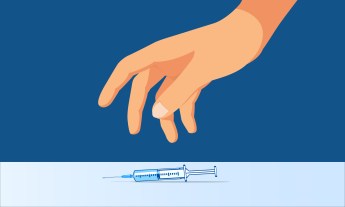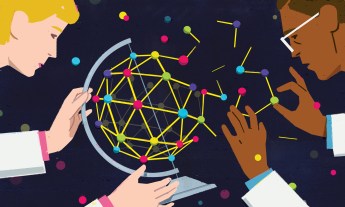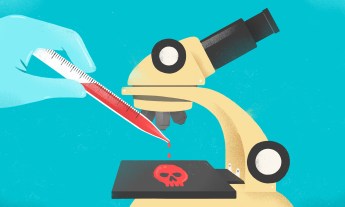
Jimmy Lin’s network helps patients with rare genetic disorders connect with the equally rare researcher who’s working on their exact problem.
Despite the medical advances we’ve witnessed over the past century or so, rare diseases are still paradoxically common. A disease is considered rare when it affects fewer than 200,000 people in the United States. Still, there are some 7,000 known rare conditions, afflicting roughly 25 to 30 million people nationwide. And of course, one problem with having a rare disease is, because only a few people have it, only a few researchers are working to cure it. For patients, finding those needle-in-a-haystack medical researchers can be near-impossible. But the number of experts is rapidly expanding. “New syndromes and new genes are being described almost every day,” says TED Fellow Jimmy Lin, a director of clinical genomics at the National Institute of Health. Lin wanted to do a better job of connecting patient with researcher (and vice versa), so he launched the Rare Genomics Institute to help. Here’s the idea.
The key: personal gene sequencing. In 2001, it cost $100 million to sequence the human genome. Today, that bill is less than $10,000. For patients with rare diseases, gene sequencing can provide the hope of a diagnosis, which often comes as a relief after years of traditional (and fruitless) tests, confusion and debilitating illness. The Rare Genomics Institute helps patients find a genetic sequencing clinic that can do the initial analysis of gene mutations that might be causing their illness. To help patients whose insurance does not cover the test or those who aren’t eligible for research grants, the Rare Genomics Institute launched a crowdfunding website where families can solicit donations via a Kickstarter-style campaign. In fact, throughout this summer and fall, they ran a pilot program, Amplify Hope, that helped families develop more effective crowdfunding campaigns.
Though of course, interpreting the genetic blueprint is still a murky business. Depending on the thoroughness of the test, a gene sequence can yield a list of up to 3 billion base pairs, the A’s and C’s, T’s and G’s that form the rungs of the DNA ladder. But getting the list is just the beginning; then scientists have to analyze it for mutations, discounting the tens of thousands of variations in the genetic code that are harmless while trying to spot the one mutation that might cause a rare disease. An additional catch: rare-disease researchers rarely have an opportunity to compare one patient to another, to find the one defect they all have in common. Unless several patients happen to converge on the same institute, researchers will inevitably draw differing conclusions. “There have been many, many examples where people get sequenced at institution A, and then later have different interpretations at institution B and C and ultimately institution D,” says Lin.
How to find the right experts. Patients have a better shot at getting a diagnosis if they share their genetic data with a range of experts. But how do they even know who the experts are? The Rare Genomics Institute offers families a “patient advocate” who stays up to date on the medical literature and can help find researchers at any one of 18 participating research institutes worldwide, including university labs at Emory, Stanford and Columbia. Patients can then work the network by, say, submitting specimen samples for sequencing at one institute, then releasing that data to others for further analysis. If they send blood samples and medical records, their appointed expert might even have enough information to design an experimental treatment. “They can basically collaborate,” Lin says, “and almost run a virtual biotech lab from their kitchen countertop.” It sounds daunting, but never underestimate the motivation of patients and their families. So far, Lin and co have worked with roughly 400 patients, a dozen of whom are now setting up larger-scale research projects tailored to their unique conditions.
How to cut the red tape. Research institutes won’t share confidential records and specimens until they have the patient’s informed consent. That means data often gets stuck in a filing cabinet. Lin’s solution: get those files into the patient’s hands so they can share the information themselves. So far, he has convinced several research institutes to automatically upload patient files to the RGI’s electronic record-keeping system, so patients can access and share the information freely. He’s now working on setting up a biobank, where patients can store specimen and tissue samples that they can quickly release to any researcher.
There’s no guarantee of a breakthrough. One-third to one-quarter of patients get a clear diagnosis from gene sequencing, and only a fraction of those find a successful treatment. Four-year-old Harrison Snow numbers among those. He suffered from a rare muscular disorder that made moving, swallowing and breathing a painful struggle. He went undiagnosed until an RGI advocate connected the family with researchers at the Scripps Institute, who sequenced his genes and discovered a rare defect linked to congenital myasthenic syndrome, a condition that causes muscles to weaken with physical exertion. From there, they connected with a gene specialist at the Mayo Clinic, who identified a promising drug to try. The turnaround was dramatic; Harrison’s mother now happily complains that she can hardly get her son to sit still any more. More typical, but still important, is a result like Maya’s, a cheerful young girl with a developmental disability doctors could only guess at. After full exome sequencing, her parents finally know more about her condition, which turned out to be the only known case of its kind.
Illustration by Davide Bonazzi @SalzmanArt for TED.












